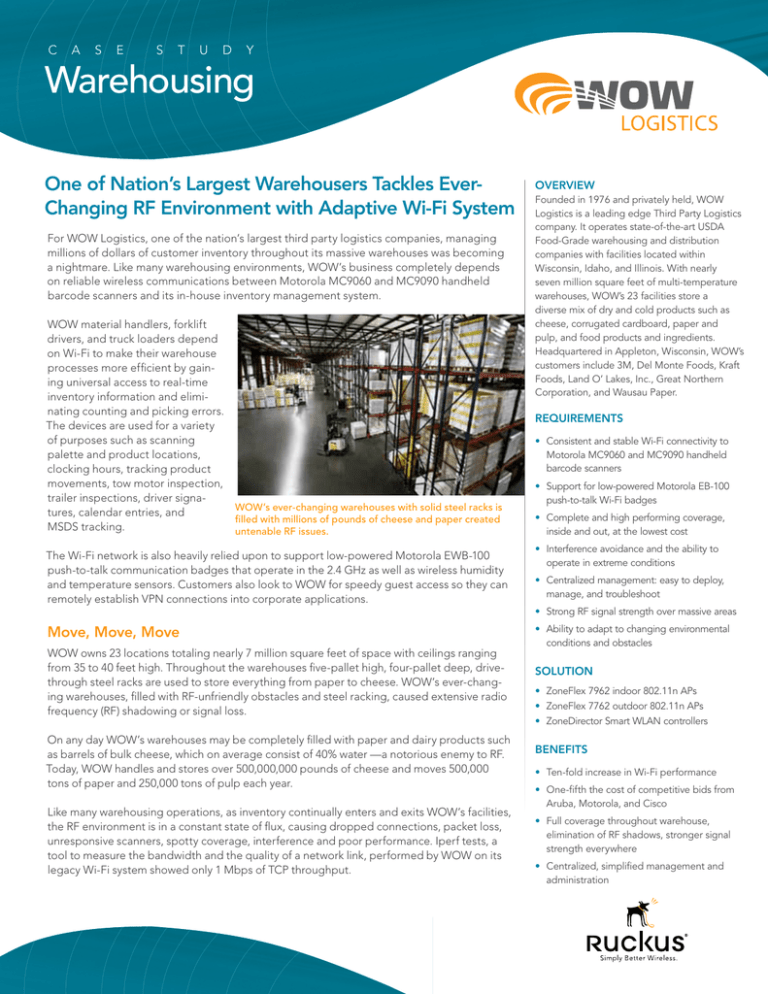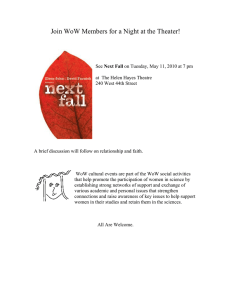Warehousing One of Nation’s Largest Warehousers Tackles Ever-
advertisement

C A S E S T U D Y Warehousing One of Nation’s Largest Warehousers Tackles EverChanging RF Environment with Adaptive Wi-Fi System For WOW Logistics, one of the nation’s largest third party logistics companies, managing millions of dollars of customer inventory throughout its massive warehouses was becoming a nightmare. Like many warehousing environments, WOW’s business completely depends on reliable wireless communications between Motorola MC9060 and MC9090 handheld barcode scanners and its in-house inventory management system. WOW material handlers, forklift drivers, and truck loaders depend on Wi-Fi to make their warehouse processes more efficient by gaining universal access to real-time inventory information and eliminating counting and picking errors. The devices are used for a variety of purposes such as scanning palette and product locations, clocking hours, tracking product movements, tow motor inspection, trailer inspections, driver signaWOW’s ever-changing warehouses with solid steel racks is tures, calendar entries, and filled with millions of pounds of cheese and paper created MSDS tracking. untenable RF issues. The Wi-Fi network is also heavily relied upon to support low-powered Motorola EWB-100 push-to-talk communication badges that operate in the 2.4 GHz as well as wireless humidity and temperature sensors. Customers also look to WOW for speedy guest access so they can remotely establish VPN connections into corporate applications. OVERVIEW Founded in 1976 and privately held, WOW Logistics is a leading edge Third Party Logistics company. It operates state-of-the-art USDA Food-Grade warehousing and distribution companies with facilities located within Wisconsin, Idaho, and Illinois. With nearly seven million square feet of multi-temperature warehouses, WOW’s 23 facilities store a diverse mix of dry and cold products such as cheese, corrugated cardboard, paper and pulp, and food products and ingredients. Headquartered in Appleton, Wisconsin, WOW’s customers include 3M, Del Monte Foods, Kraft Foods, Land O’ Lakes, Inc., Great Northern Corporation, and Wausau Paper. REQUIREMENTS • Consistent and stable Wi-Fi connectivity to Motorola MC9060 and MC9090 handheld barcode scanners • Support for low-powered Motorola EB-100 push-to-talk Wi-Fi badges • Complete and high performing coverage, inside and out, at the lowest cost • Interference avoidance and the ability to operate in extreme conditions • Centralized management: easy to deploy, manage, and troubleshoot • Strong RF signal strength over massive areas Move, Move, Move WOW owns 23 locations totaling nearly 7 million square feet of space with ceilings ranging from 35 to 40 feet high. Throughout the warehouses five-pallet high, four-pallet deep, drivethrough steel racks are used to store everything from paper to cheese. WOW’s ever-changing warehouses, filled with RF-unfriendly obstacles and steel racking, caused extensive radio frequency (RF) shadowing or signal loss. On any day WOW’s warehouses may be completely filled with paper and dairy products such as barrels of bulk cheese, which on average consist of 40% water —a notorious enemy to RF. Today, WOW handles and stores over 500,000,000 pounds of cheese and moves 500,000 tons of paper and 250,000 tons of pulp each year. Like many warehousing operations, as inventory continually enters and exits WOW’s facilities, the RF environment is in a constant state of flux, causing dropped connections, packet loss, unresponsive scanners, spotty coverage, interference and poor performance. Iperf tests, a tool to measure the bandwidth and the quality of a network link, performed by WOW on its legacy Wi-Fi system showed only 1 Mbps of TCP throughput. • Ability to adapt to changing environmental conditions and obstacles SOLUTION • ZoneFlex 7962 indoor 802.11n APs • ZoneFlex 7762 outdoor 802.11n APs • ZoneDirector Smart WLAN controllers BENEFITS • Ten-fold increase in Wi-Fi performance • One-fifth the cost of competitive bids from Aruba, Motorola, and Cisco • Full coverage throughout warehouse, elimination of RF shadows, stronger signal strength everywhere • Centralized, simplified management and administration C A S E S T U D Y Warehousing “Large warehouses pose unique RF propagation problems for any Wi-Fi system because the environment constantly changes and users are almost always mobile. Without a good Wi-Fi system our business literally stops. “Warehouses are brutal on Wi-Fi because everything is always changing and these spaces are full of materials that just kill Wi-Fi signals,” said Dave Christianson, network administrator for WOW Logistics. “Getting Wi-Fi to work well with water and steel was turning into a science project.” Out with the Old, In with the New WOW’s previous Motorola wireless LAN (WLAN) system was based on reference-design Wi-Fi access points (APs) equipped with dipole omnidirectional antennas. With this fixed antenna structure, the Motorola APs were unable to alter the Wi-Fi signal path as RF problems arose. Also, more APs were typically required to cover a given area due to their 360º omni antenna patterns that can often cause co-channel interference. So we went looking for a wireless solution specifically designed to adapt and deal with RF ambiguities. “We found that pretty much every supplier had the same problem,” commented Christianson. “They all use basic omni antennas that were not able to focus RF energy only where it’s needed, and no way to combat unexpected interference or obstacles as they crop up.” We only found one.” WOW settled on four vendors to bid on the project: Motorola, Cisco, Aruba, and Ruckus Wireless. Dave Christianson Network Administrator WOW Logistics RIGHT WOW operates dry, refrigerated and freezer warehousing facilities that consume nearly 7 million square feet of space across three states. WOW needed a stronger Wi-Fi network that could deliver better service to 98 Wi-Fi-enabled Motorola bar code scanners and 40 badges used for inventory management. However the price points for the Cisco, Aruba, and Motorola APs and the licensing costs were “outrageously” expensive with the most costly option being 68% higher than the Ruckus system. Because Ruckus uses a high-gain, directional adaptive antenna array integrated into every AP, its system typically requires 30 to 40% fewer APs. And it wasn’t just the cost of the APs that was giving Christianson sticker shock. With initial and reoccurring licensing costs quoting in the $20 to $25K range for just one controller to manage 60 APs, with two controllers per location, WOW was looking at spending over a $500,000 dollars on controllers alone. The Ruckus system came in at 1/5th the price. “Price wasn’t the lone consideration,” said Christianson. “It was imperative that we solve our wireless problems or our business would falter. That said, we were astounded at the hidden costs we discovered in other vendors systems to the point where it didn’t even make sense to consider them. While the vendors had comparable controller and management capabilities, only one combined them with a well-thought out AP for truly harsh RF situations, both indoors and out.” Finally, Wi-Fi for Warehouses With plans to install 400 to 500 APs throughout its warehouses, Christianson selected the Ruckus ZoneFlex system and began the Wi-Fi replacement process within WOW’s corporate offices in Appleton, Wisconsin. C A S E S T U D Y Warehousing “Iperf tests of our legacy WLAN showed only 1 Mbps of TCP throughput if connectivity could be maintained. After installing the Ruckus ZoneFlex system, the Iperf numbers jumped to 83 Mbps of throughput with strong, consistent and complete signal coverage. But the best part is the system’s simplicity and affordable cost. Now instead of worrying about the Wi-Fi network, we are looking for new ways to use it to improve business processes.” Dave Christianson Network Administrator WOW Logistics BELOW With over 350,000 square feet of space, WOW’s “Little Chute” warehouse stores product that defeats RF propagation. WOW replaced its legacy Motorola APs with Ruckus ZoneFlex 7363s. The ZoneFlex 7363 is a mid-range, two-stream, 2X2, dual-band (5 GHz/ 2.4 GHz) 802.11n indoor AP that integrates a miniaturized adaptive antenna array, one for each band. Staff at WOW’s corporate office saw an immediate improvement in both throughput and coverage. Christianson ran another set of Iperf tests to get a before and after comparison. He found with Ruckus, Wi-Fi speeds were now topping 83 Mbps of TCP throughput everywhere. “From the moment the Little Chute deployment began, I began receiving unsolicited, positive feedback from the warehouse staff as they began noticing that their handheld scanners and push to talk wireless radio badges were performing orders of magnitude better,” said Christianson. Next, WOW chose to upgrade the Wi-Fi within its “Little Chute” warehouse (pictured above) that primarily stores paper/pulp and dairy products in over 350,000 square feet of storage space. At this facility, WOW chose the Ruckus ZoneFlex 7962, a dualband 802.11n AP with a dual-polarized directional antenna array, mounting 35 of them on I-beams in the ceiling. Truck drivers are not always able to leave their truck, so it is essential for the dock worker to maintain wireless connectivity while checking in/ out each truck load. Now that WOW has the outdoor ZF7762 APs, that feature built-in heaters for cold climates (-40° C), WOW has not had a single instance where wireless communication to the badges has been lost. A single Zone Director controller in each facility controls all Ruckus APs for that location, with a redundant controller then located at their corporate headquarters. All Zone Directors are then centrally configured and controlled using Ruckus’ FlexMaster management software. Sitting outside the datapath, the ZoneDirector provides advanced features such as smart meshing, AP groups, WLAN groups, guest access, client throughput thresholds, time-ofday radio broadcasting, client load balancing and sophisticated security capabilities. From a single dashboard, WOW administers its entire indoor and outdoor network across multiple locations. Christianson added ZoneFlex 7762 dual-band outdoor APs to ensure that WOW’s dock workers were able to maintain voice communications when exiting the truck bay area. What’s Next for WOW? Christianson plans to have Ruckus Wi-Fi deployed in all of its warehouse locations by the end of 2012. Looking ahead, as WOW is considering a number of Wi-Fi applications such as location-based tracking of employees and products as well as video surveillance. “At the end of the day the Ruckus Wi-Fi system has helped us to create more efficiencies that ultimately helps us to better serve our customers,” said Christianson. “You might even say that Ruckus is helping WOW Logistics become the ‘Big Cheese’ amongst its 3PL peers.” Copyright © 2012 Ruckus Wireless, Inc. All rights reserved. Ruckus Wireless and Ruckus Wireless design are registered in the U.S. Patent and Trademark Office. Ruckus Wireless, the Ruckus Wireless logo, BeamFlex, ZoneFlex, MediaFlex, FlexMaster, ZoneDirector, SpeedFlex, SmartCast, and Dynamic PSK are trademarks of Ruckus Wireless, Inc. in the United States and other countries. All other trademarks mentioned in this document or Website are the property of their respective owners. 802-71010-001 rev 02 w w w.r u c k u s w i re le s s .co m







